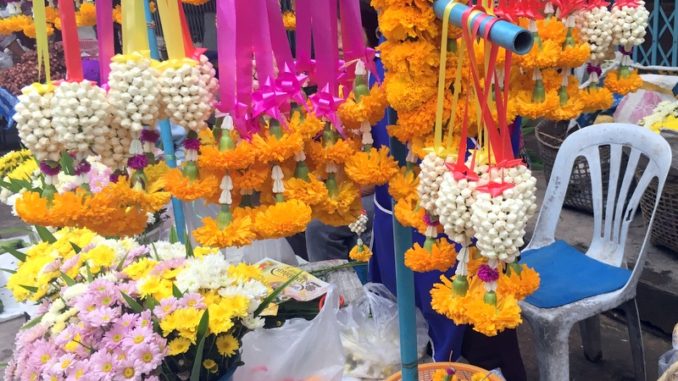
It’s worth getting up early for NAN markets in northern Thailand
I’ve been to dozens of Asian and European markets over the years. For some reason, I’m drawn to vegetables – the more exotic the better – and luscious fruit as well.
I’m not crazy about raw meat, so I walk past that section quite quickly, only giving the produce the most furtive of glances. I remember my vegan friend being horrified when she almost entered the meat section in a huge (and very chaotic) market in Ubud, Bali a couple of years ago. I wasn’t that keen myself, but I had to follow our group leader for fear of getting lost. We were doing a cooking class after the markets and it paid to stick close to the guide as we wandered through the labyrinth.
Thai morning markets have a special quality. That’s because locals and visitors can make offerings to the Buddhist monks and their young novices, (who are generally teenagers but can be as young as seven) who stroll about the area just after dawn. They wear an array of robes (some which cover the body and others where one shoulder and arm are free) in hues that range from russet to saffron and bright orange, which make for a colourful sight.
The ritual is known as giving alms, or tak bat in Thai. I’ve taken part in two quite informal ceremonies over the years – in central and northern Thailand, the most recent in Nan, a lovely city of around 20,000 people, east of Chiang Mai as the crow flies but about 300 km away via a series of winding roads.
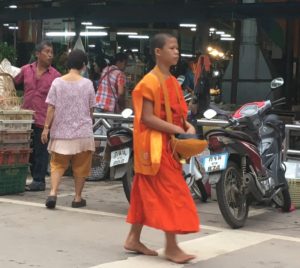
Our group of Aussie travellers was up and out of our hotel by 6 am, in readiness for the Nan morning market, which was already bustling at this early hour. On arrival, our guide gave us some quick instructions on what to do when the monks arrived. She handed each of us a pre-packaged offering – a small bungle of goods consisting of sticky rice, water and sweet snacks – purchased from a nearby vendor (at 35 baht each or about $1.50) to give to a monk as he walked past, in exchange for a blessing. We lined up waiting and before we knew it the monks seemed to appear from nowhere – a group of six or so young men walking towards us in single file. Our group got into position, holding our gifts in readiness.
As the monks stopped in front of us, we knelt and handed our gift up to a young man. It all happened in a flash of saffron. I didn’t have time to even notice if we were blessed, but I’m sure we were. The monks then placed the gifts in a large steel bowl each of them was carrying in a cloth bag worn over their shoulder. They moved on – no words were exchanged.
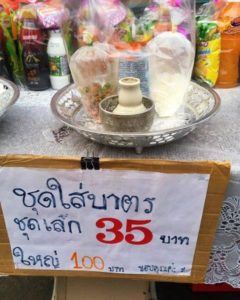
Once his bowl is full, the monk I’m told returns to the temple where the food is shared among the congregation. Each monk is allowed two small meals a day (which can include meat), and what’s not eaten by the monks is distributed to the poor. If there’s anything left over, it’s given to the cats and dogs that hang about the monastery.
Once our part of the ritual was over, I had time to take a few photos of the monks whose bowls weren’t quite full and who continued to walk barefoot around the town accepting offerings. As it’s a daily ritual and a pillar of Buddhist life, the locals are used to it and life at the market carries on as normal. Of course, for we tourists, the brightly-coloured robes and the offerings make great photos, if you’re quick. I’m not that speedy a photographer (and on this occasion was only using an iPhone), so my shots are not the best.
Some ceremonies have become quite the tourist spectacle I’ve read, (especially in Luang Prabang, Laos) where tourists jostle for the best photos and create a level of chaos out of keeping with the spirit of the occasion. But here in regional Nan, away from the madding crowd, it’s still a peaceful process. I did notice one Asian man carrying what looked like a professional TV camera. He was standing near the head monk, who wasn’t walking but was motoring slowly about in what looked like a cross between a motorbike and a rickshaw. (Perhaps the cameraman was making a documentary).
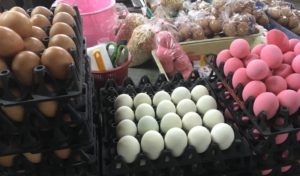
Nan markets are fascinating – the best I’ve visited in many years. I think that’s because they are small (with not much chance to get lost) but fascinating and the food looked fresh and inviting. Although relatively busy, the stallholders weren’t too pre-occupied with customers and had time to nod and smile at us. I was fascinated by the pink coloured eggs – perhaps they were for kids – and loved the little coconut milk ‘hotcakes’ that one trader was making over a hot griddle.
A colleague and I waited patiently for her batch of hotcakes to ‘cook’ and then waited for them to cool before we could pop them in our mouths. They would have been perfect with coffee, but time was against us and I didn’t notice a coffee vendor nearby. Thai coffee is another treat if you can find it – make by filtering the grounds through a muslin bag and adding sweet Carnation milk. Other items I spied weren’t so cute – a bucket of wriggling snakes and another full of tiny turtles swimming desperately about in the confined space. I wondered about their fate – and of course, speculated as to who was going to buy the snakes and what for?!
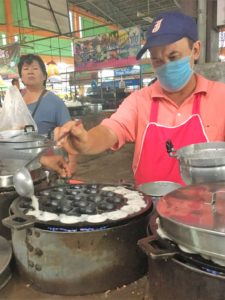
It’s certainly worth sacrificing a bit of sleep and getting up early to hit the markets – there’s a buzz in the streets, the monks make for a fascinating sight and there’s always a sweet treat on offer. And who doesn’t like their day to begin with a blessing?

Getting there: The best way to get to Nan is to fly. It’s just over an hour from Bangkok’s Don Mueang Airport. The cutely-named Nok Air (whose planes are painted with a duck’s bill on the nose) fly five times a day; Air Asia flies twice a day. There are also two flights a week from Chiang Mia airport on Kan Air, taking approximately 45 minutes.
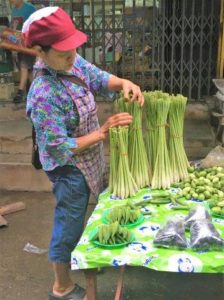
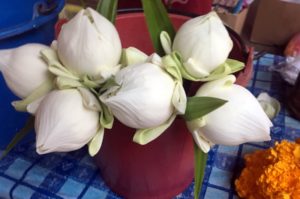

Love this post Caroline – you have captured our Nan morning beautifully! Wish we could magically swing back here for a couple of days right now, actually!
Thanks so much Amanda. Loved Nan – and Phrae; they are really special ‘untouched’ parts of Thailand.
cheers, Caroline